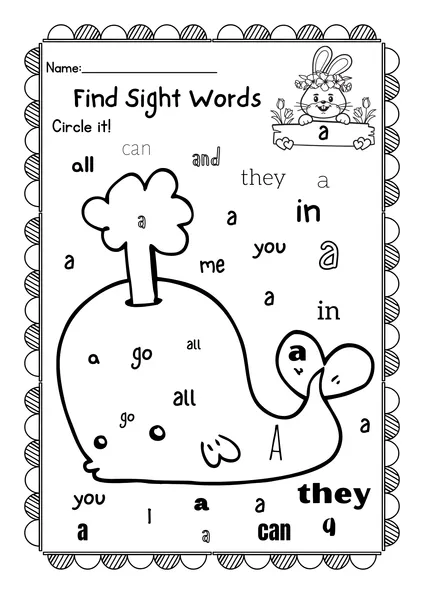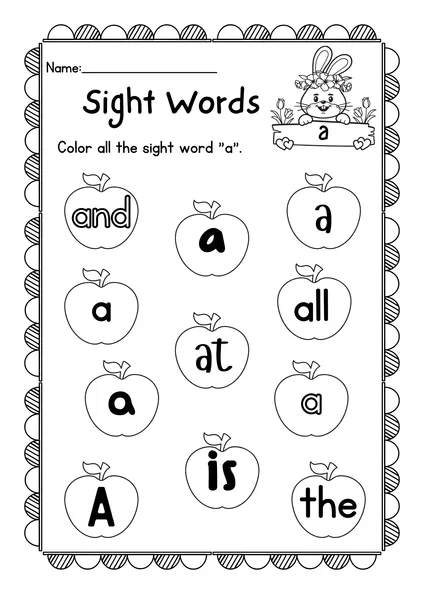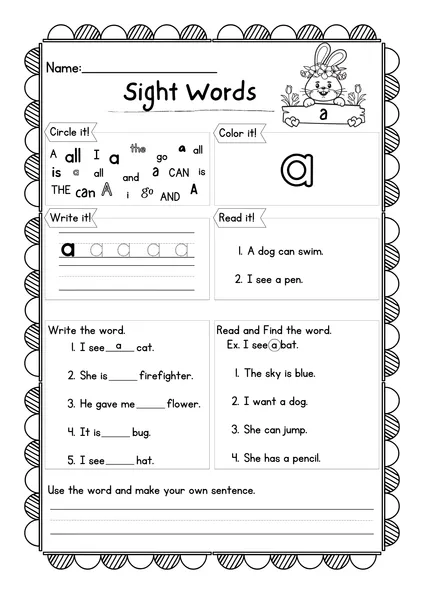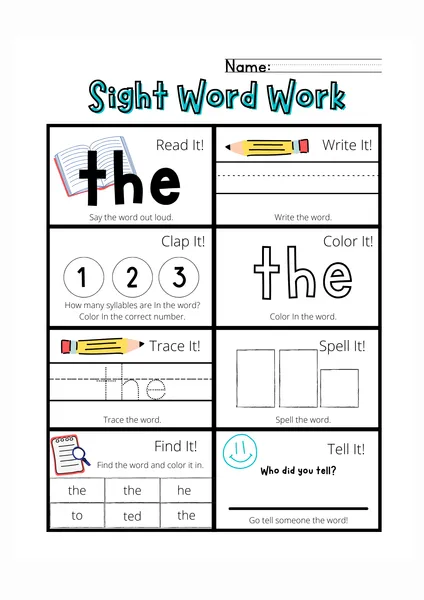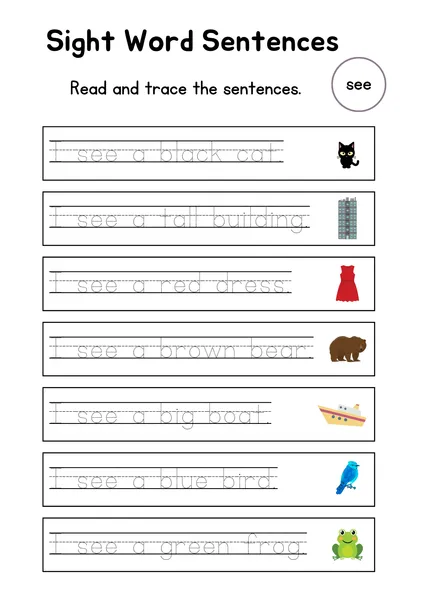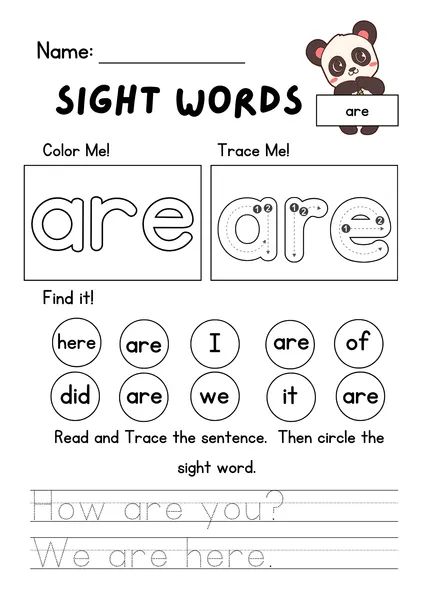Free Printable Kindergarten Sight Word Worksheets, expert tips & activities to boost reading skills.
An essential part of learning this process is appropriately reading sight words. So, people might be wondering what sight words are right now. Those are its primary words – the kinds of words children are beginning to recognise in the books they are learning to read independently. Hearing ‘the’, ‘a’, ‘and’, ‘is’, ‘you’. Since these words are practical, identifying them right away, or ‘on sight’, significantly improves reading speed.
Why are such words so relevant? Well, imagine having to ‘draw’ the pronunciation of every book in a sentence, the pronunciation that guides readers on how to read the prose. Yeah, it would be slow going, wouldn’t it? When children can identify the so-called immediate’, they can expend their efforts and energy to work through the increasingly difficult-to-sound-out words. This enhances reading by making it a lot easier, quicker and simply far more fun to read. But if reading is fun, then kids will read all the more.
A Kindergarten Teacher’s List of Common Sight Words
That way, We learned which sight words challenge the kids most and which ones they should be as familiar with as they are the back of their hands. For example, there is the Dolch Sight Word List and the Fry Instant Words; honestly, they are just variations of the same thing for kindergarten.
Below are some of the most frequently needed kindergarten sight words we have determined. We’ve broken them down into smaller, more manageable chunks:
Group 1: The Foundation
- a
- I
- the
- and
- is
- my
- to
- go
- me
- like
Group 2: Building Blocks
- on
- in
- it
- you
- up
- at
- see
- we
- can
- am
Group 3: Expanding the Vocabulary
- he
- she
- do
- so
- no
- an
- are
- with
- all
- look
Group 4: Adding More Tools
- for
- have
- of
- that
- this
- was
- what
- said
- here
- come
- has
Group 5: Almost There!
- play
- are
- who
- will
- be
- by
- they
- one
- two
- from
Important Note: Do not feel pressured to do all these words simultaneously. Introduce them in batches. The number to be introduced at any time should be considered carefully to ensure the practitioner masters using the technologies before the next set is introduced in the classroom.
Fun Activities You Can Use to Make Sight Word Practise More Enjoyable
However, practising these words with flashcards can become boring rather quickly. Believe me, once in a while, we saw those little eyes glistening before me! The main idea, therefore, is to help the learners enjoy every word or symbol they are taught until they can identify it at first sight. Here are some tried-and-true activities that have worked wonders in my classroom:
1. Sight Word Games:
- Sight Word Bingo: Instead of numbers on the bingo cards, use only sight words. SAY the words, children blindfold and place them back on their cards. Round one winners get the bingo!
- Sight Word Memory: Prepare two sight word cards and put them face down. Two children then turn over two cards at a time to try and match two cards.
- Sight Word Fish: Just as in Memory, people guess to others what words are on the card instead of turning them over. “Do you have the word ‘the’?”
- Sight Word Hopscotch: Sight words should be written in the squares drawn on hopscotch graphs. When learning to hop, they are urged to read whatever word they step on.
2. Hands-On Activities:
- Playdough Words: Section 7: Have the children roll playdough “snakes” and use them to write the sight words.
- Sand/Salt Tray Writing: Aggressively fill a small flat dish basin with sand or salt. The child can write commands straight on the tray with a finger or a small stick.
- Shaving Cream Writing: You have children write quick, simple words known as sight words in shaving cream on a table or tray. It’s messy but fun!
- Build with Blocks: Often use small blocks to write sight words. In the construction process, children can stack the blocks to create towers or write the words on them.
3. Creative Arts and Crafts:
- Sight Word Rainbow Writing: Children write each sight word many times, starting with one colour, the second colour, and so on, resulting in the formation of rainbows.
- Sight Word Collage: Children can use the sight words found in magazines or newspapers to make a collage by cutting them and glueing them on a piece of paper.
- Sight Word Paintings: Let children write sight words on large sheets of paper using paint and brushes.
- Sight Word Bracelets/Necklaces: Using letter beads, you can write out the sight words and devise bracelets to remind the students.
4. Reading and Writing Connections:
- Sight Word Hunt: Whenever children are reading books together, they should be asked to Name that word they see.
- Sentence Building: Use a set of sight word cards for children and introduce the practice of writing simple sentences by children themselves.
- Sight Word Stories: Sight word practice, using as many passwords as possible when writing a short story with a partner.
- Daily Journaling: The third approach is to assign children to write a few sentences each day using the sight words learned.
5. Technology in Moderation:
- Sight Word Apps: One can quickly get many free apps for activities like sight word games. When using this technique, select applications suitable for the learner’s age and interest.
- Online Sight Word Games: Children can always find sight word games on the internet and can efficiently utilise a computer or a tablet to play them.
Tips for Parents and Teachers: Making the Magic Happen
Here’s the thing about teaching sight words: it’s not a race. It’s about the fact that nobody is ready to write a book on the first day, and it is all about establishing the base, letter by letter. Here are some tips:
- Keep it Short and Sweet: The optimal is to conduct five to ten minutes of practice sessions several times daily.
- Focus on a Few Words at a Time: Avoid using many new words simultaneously because it becomes difficult for children to memorise all. Teach new words, 2-3 at a time; still, Revision is key.
- Make it Multisensory: Incorporate all senses and organs of communication by featuring activities that include viewing, listening, vocalising and writing the words.
- Be Patient and Positive: Learning takes time. Reward progress and motivate the break-off as progress is made intermittently.
- Read Together Every Day: The practice of reading aloud means the literals get into contact with sight words in functional use by the second year and comes with the added benefit of making literal development of a love for books.
- Create a Print-Rich Environment: Surround children with words! Attach labels on the objects in the house or classroom, have cutouts of sight word pictures and have an assortment of books accessible.
- Turn Everyday Moments into Learning Opportunities: Teach the child to look for such words on signs, menu cards or on the fronts of cereals’ boxes, etc.
- Don’t Forget to Review: Review previously learned sight words to refresh the learners’ memory about them.
Free Printable Sight Word Worksheets
Let us return to those essential worksheets we should hand in sometime today. As much as We love practical activities, practising on worksheets is also good, plus revising what children have learnt is helpful. Here are some ideas for free printable sight word worksheets you can create:
1. Sight Word Tracing and Writing:
Worksheet Idea: every page covers one sight word a child would be expected to recognise upon sight. The word appears to be written in capital letters, is very big, and is black at the top of the page. At the bottom is a section with several lines of flowy dotted letters for the child to trace before three blank lines where the child can practise writing the word independently.
2. Sight Word Matching:
Worksheet Idea: Create two columns. One column contains a list of sight words, while the other includes the exact words but in different order. The children will draw lines between the two words we are looking for to find pairs.
3. Sight Word Search:
Worksheet Idea: If a regular word search is just finding words horizontally, vertically or diagonally across the puzzle grid, then this is a sight word search. If you want a more complex activity, you can make the grid smaller/more prominent and arrange the vocabulary in horizontal, vertical, or diagonal directions.
4. Fill in the Blank:
Worksheet Idea: Give short sentences with an underscore that indicates a sight word must be inserted. At the top or bottom of the page, provide a word list for the omitted sight words. Children pick the word that best fits each sentence.
5. Color by Sight Word:
Worksheet Idea: Make a picture by dividing it into sections and writing a sight word in every section. Give a colour code to each word as in the example, “the” ’ll be coded red “and” blue. Children pick the colour they like for the specific sight word for the section.
6. Cut and Paste Sentences:
Worksheet Idea: Complete as many precut words (including sight words) as possible. A child puts all the words together to form the correct sentence and pastes all the written words on a different sheet of paper.
7. Roll and Read:
Worksheet Idea: On a piece of paper, write various sight words in each of the spaces on the game board. You will also need a die. Children take turns using the die to move the counter or any small object they are using around the race path. They must then read the sight word assigned to them on the picture they pick.
8. Sight Word Fluency Strips:
Worksheet Idea: Make paper strips with minimal letter words and the target sight word. Incoming readers attempt to read the strips aloud as much as possible to attain reading automaticity using Schick and Melber’s (1990) term.
9. Sight Word Assessment:
Worksheet Idea: An essential list of all the sight words your child/students are expected to learn and recognise. Occasionally, you should come across them and make them go through the list and tick those they are sure they can answer. This helps to keep records and determine which words are more complex and require more practice.
Remember: It is very easy to locate these worksheets online or by checking from the nearest store; otherwise, it only takes a little DIY talent to create a worksheet on your own or any word processing program.
Free Printable Kindergarten Sight Word Worksheets
Final Thoughts
Sight word recognition is usually one of the developmental stages in every child’s learning-to-read process. Another approach to helping your little ones learn these foundational words is through fun activities, colourful crafts and focused worksheets to bring out the magic of reading—patience, positivity, and always showing appreciation if not for the progress achieved so far. One has to fully appreciate seeing a child happy when he can read a whole sentence that he has read by himself. Let’s make fun of teaching these sight words and see those young minds grow to become great readers! So if you have any queries, you know where to find us. Anyway, we all are in this together and enjoying the process of developing a reader for the generation to come, one sight word at a time!
